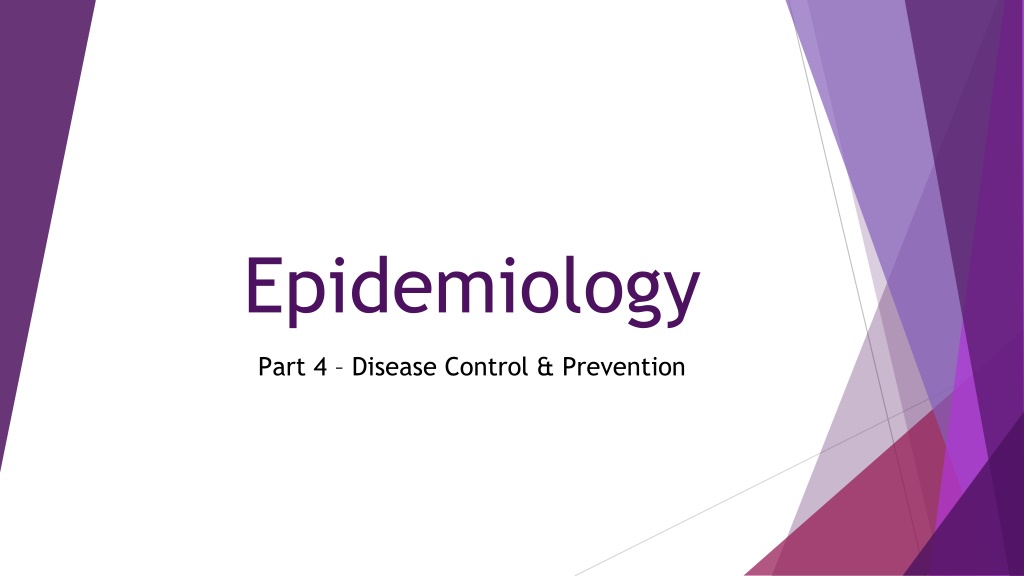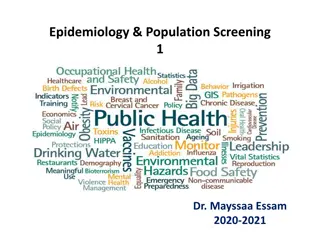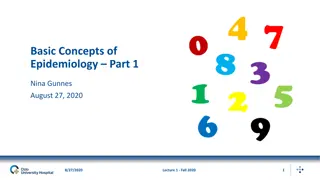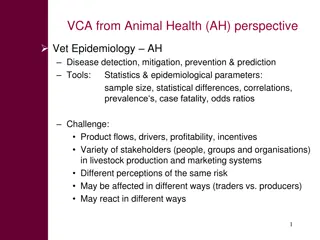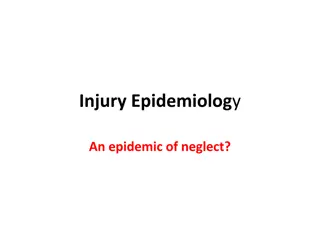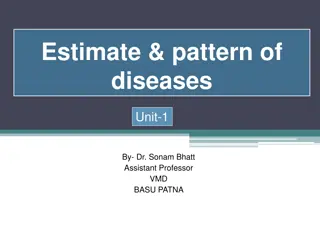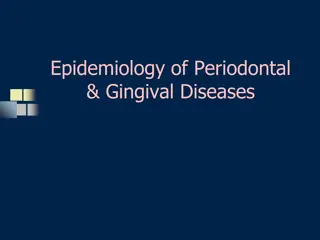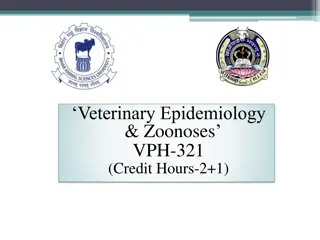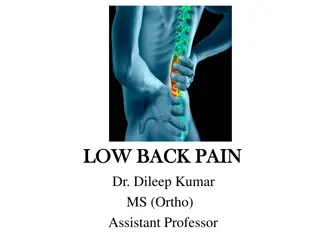Understanding Disease Control and Prevention in Epidemiology
This article discusses disease control processes in epidemiology, including reducing disease incidence, duration, and transmission. It covers public policy interventions, elimination, eradication, and extinction of infectious agents. It also highlights preventable causes of disease and different levels of disease prevention. Various tools such as behavior change, vaccines, surveillance, and environmental modifications are explored for controlling infectious diseases.
Download Presentation

Please find below an Image/Link to download the presentation.
The content on the website is provided AS IS for your information and personal use only. It may not be sold, licensed, or shared on other websites without obtaining consent from the author. Download presentation by click this link. If you encounter any issues during the download, it is possible that the publisher has removed the file from their server.
E N D
Presentation Transcript
Epidemiology Part 4 Disease Control & Prevention
Infectious Diseases - How do we control them? This video takes a look at how infectious diseases are transmitted and a look at the different tools we have to control them. We take a quick look at how we can use behavior change, vaccines, surveillance, environmental changes, infection control and medication to control the spread of infectious diseases This video was created by Ranil Appuhamy Voiceover - James Clark For more information about infectious diseases, have a look at these websites: http://www.who.int/topics/infectious_diseases/en/ https://www.cdc.gov/diseasesconditions/ https://wwwnc.cdc.gov/eid/ -------------------------------------------------------------------------------------------------------- Disclaimer: These videos are provided for educational purposes only. Users should not rely solely on the information contained within these videos and is not intended to be a substitute for advice from other relevant sources. The author/s do not warrant or represent that the information contained in the videos are accurate, current or complete and do not accept any legal liability or responsibility for any loss, damages, costs or expenses incurred by the use of, or reliance on, or interpretation of, the information contained in the videos.
Disease Control Disease control describes ongoing operations aimed at reducing: The incidence of disease The duration of disease and consequently the risk of transmission The effects of infection, including both the physical and psychosocial complications The financial burden to the community 3
Disease Control Process Disease control involves: Control - public policy intervention that restricts the circulation of an infectious agent beyond the level that would result from spontaneous, individual behaviors to protect against infection Elimination reduction to zero of the incidence of specified disease in a defined geographical area as a result of deliberate efforts Eradication termination of all transmission of infections by extermination of infectious agents Extinction the specific infectious agent no longer exists in nature or in the laboratory 4
Preventable Causes of Disease BEINGS Biological factors and Behavioral Factors Environmental factors Immunologic factors Nutritional factors Genetic factors Services, Social factors, and Spiritual factors [JF Jekel, Epidemiology, Biostatistics, and Preventive Medicine, 1996] 5
Levels of Disease Prevention Primordial Prevention establish or maintain conditions to minimize health hazards Target: Whole population through public health policy Example: Advocacy for social change to make physical activity easier Primary Prevention prevent disease well before it develops by reducing risk factors Target: Whole population, selected groups, & healthy individuals Example: Primary care advice during a routine consultation Secondary Prevention early detection of disease through screening Target: selected individuals with high risk patients Example: Primary care risk factor reduction for those at risk of a chronic disease, fall, or injury Tertiary Prevention target established disease to prevent deterioration Target: Patients Example: Exercise advice as part of cardiac rehabilitation 6
Natural History of Disease Onset of symptoms Usual time of diagnosis Exposure Pathologic changes Stage of recovery, disability or death Stage of subclinical disease Stage of susceptibility Stage of clinical disease PRIMARY PREVENTION SECONDARY PREVENTION TERTIARY PREVENTION 7
Strategy for Prevention Identify Populations at High Disease Risk (based on demography / family history, host factors..) Modify Existing Intervention Programs Assess Exposure Evaluate Intervention Programs Conduct Research on Mechanisms (including the study of genetic susceptibility) Apply Population-Based Intervention Programs 8
Prevention Approaches Population-Based Approach: Preventive measure widely applied to an entire population (public health approach) Strive for small absolute change among many persons Must be relatively inexpensive and non-invasive High-Risk Approach: Target group of individual at high risk Strive for strong risk factor control Often times requires clinical action to identify the high risk group and to motivate risk factor control 9
Monitoring Refers to the performance and analysis of routine measurements aimed at detecting changes in the environment or health status of population Monitoring of air pollution, water quality, growth and nutritional status It also refers to ongoing measurement of performance of a health service or a health professional, or of the extent to which patients comply with or adhere to advice from health professionals. 10
